
In cities around the world, e-bikes, scooters, and motorcycles make up the brunt of the food delivery industry. They serve as the critical backbone, connecting hungry customers ordering app-based food with the restaurants that serve up that savory delight. At least, that’s how it works almost everywhere except North America. So I took a trip to the US and spent a day as a food delivery rider to see what the big hangup is.
If you don’t know me, then hello! I’m an electric bike journalist and YouTuber, or at least that’s my normal day job. But this summer I hung up my keyboard for a day and hopped on an e-bike in South Beach, Miami to try Doordashing during a busy afternoon.
My ride for the day was a Lectric XP 3.0 folding e-bike, outfitted with a cargo package and food delivery bags. It’s a great bike for this type of use thanks to its low entry price (), its low frame, and its small diameter fat tires that make it easy to cruise rough city streets and hop curbs or potholes when necessary.
I made an action-packed video of my day here, and you should check it out if you want the firsthand experience of food delivery by e-bike (and a little Miami culture at the same time).
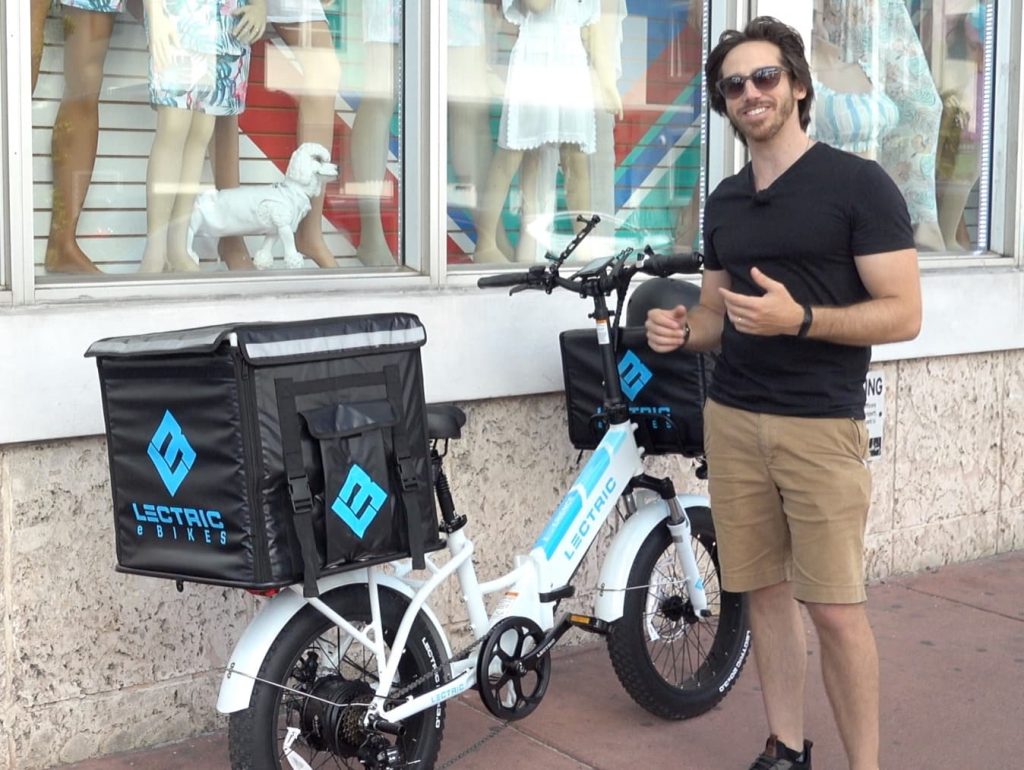
My goal for the day wasn’t necessarily to make money, though that was a nice side-benefit of the experiment. This was a job, after all (albeit an “independent contractor” job that allows the food app companies to avoid paying a living wage or benefits).
Instead of money, my main goal was to earn experience and insight into what goes into trying to deliver food by e-bike in the US. [And as a quick note: yes, I’m aware e-bike riders are the main delivery method in New York City. Congrats NYC, you’re the only US city that has mainly figured it out. Some other areas like San Francisco are on their way, but for the most part, the US is a laggard in this regard.]
If my goal had been to earn good money on this adventure, I would have been disappointed. More on that in a moment. But since the experience was my aim, I definitely came out as a winner. See what I learned below.
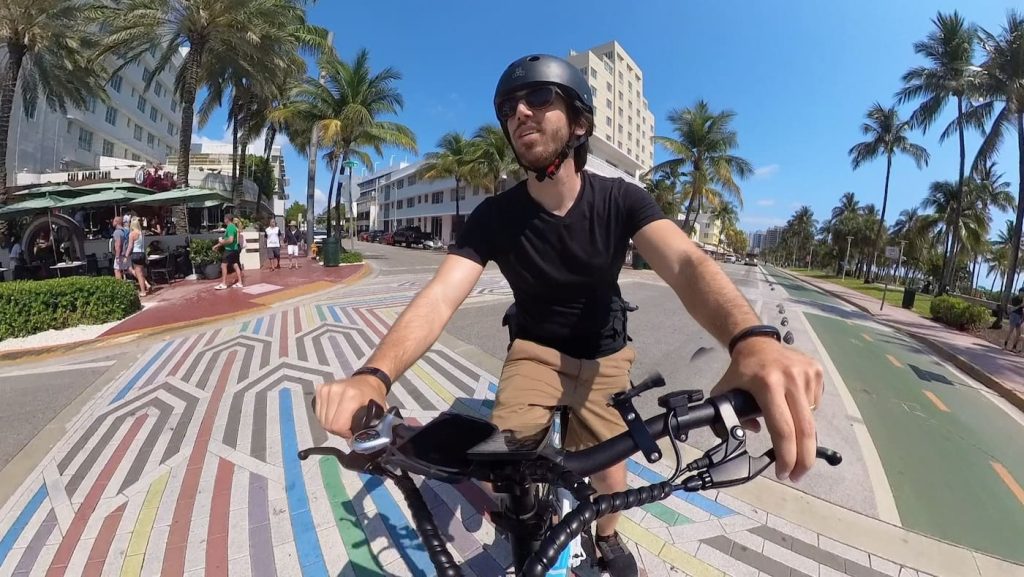
Delivery riders don’t make much money
In total, my day consisted of four and a half hours of food delivery in the bustling South Beach area, covering the lunch rush from 11:00 to 15:30, chosen to (hopefully) maximize profit. Over that period, I delivered nearly a dozen orders from a wide range of restaurants, smoothie bars, cookie shops, liquor stores, and more.
I raked in a total of US $48.75, or roughly $10.80/hour. That included tips, which in fact were a majority of my earnings. For comparison, the minimum wage in Florida where I was riding is $12/hour.
One of the main issues limiting my income was that the app just didn’t seem to give me many offers to deliver food. There were several periods where I was sitting in a “hot spot” as designated on the map in the app, but it took 30 minutes until I received a low-paying offer, such as $3.50 to pick up a McDonald’s order and deliver it. That was the second issue, that the offers simply paid poorly.
Anecdotal evidence from the experience of other delivery workers shows that these food apps often prioritize delivery car drivers over riders, though the exact reason isn’t clear. The apps won’t admit to this practice, but the workers seem pretty confident in its veracity. After talking about my experience with other Doordash delivery workers, several told me that the low-paying orders I got probably sat around for a while on the app getting passed over by delivery drivers until they were finally offered to me.
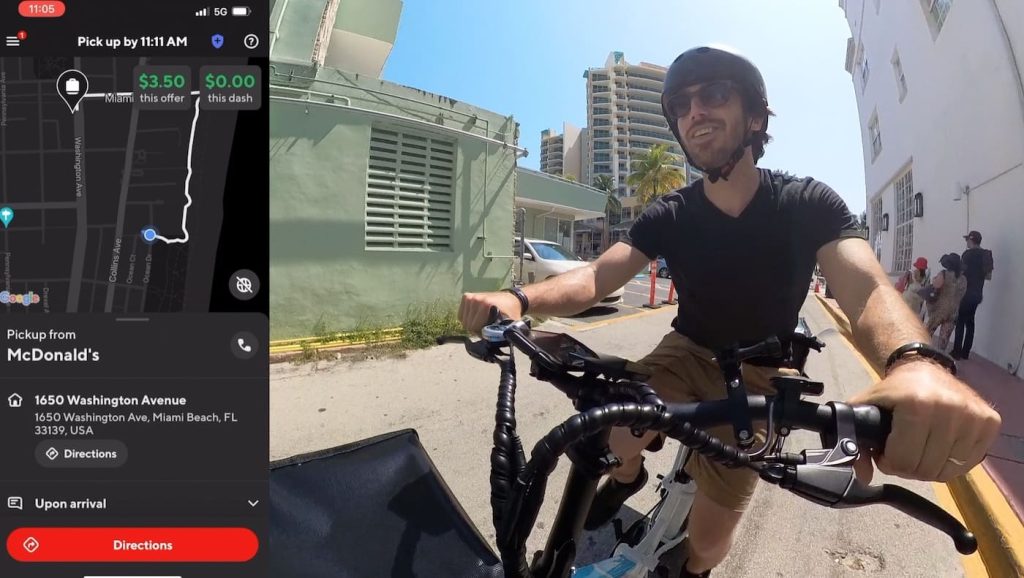
Cars don’t make space for you
Where I live in Tel Aviv, bikes share the road. There’s also a large motorcycle and scooter culture, so car drivers are used to seeing two-wheelers on the road, and they generally move over to make space. That’s not the case in Florida, nor much of the US. The only place I’ve seen it in the US is in California, where drivers tend to move over for me when I’m lane-splitting on a motorcycle – though they’re also required to by law.
I found that South Beach in Miami had a decent amount of bike lanes, though they were usually just painted onto the road and thus don’t offer much real protection from cars. A few areas, such as the main beach road, had protected bike lanes separated by physical barriers.
Since I was riding a relatively fast e-bike (up to 28 mph or 45 km/h), I would often slide out of the painted-on bike lane and into the main road, especially when I could travel faster than cars in traffic or other pedal bikes ahead of me in the bike lane. Boy, the drivers did not like that! Forget the fact that the drivers were stuck in bumper-to-bumper traffic sometimes – those drivers still seem to hate seeing cyclists blow past them on the road.
Fortunately, I didn’t experience aggressive enough driving to the point of fearing harm, though such accounts are sadly numerous among cyclists in the US. It can be dangerous riding a bike with cars in the US, partially due to the lack of proper infrastructure and partially due to drivers just seeming to be surprised at seeing a bike sharing the road with them. And while road rage against cyclists accounts for a smaller segment of the injuries and deaths than good old-fashioned distracted operating of heavy machinery, it’s still an important consideration.
These lurking dangers are something that cyclists simply have to keep in mind. The road is ours too, but we can’t afford the same disregard that drivers have been permitted. We always have to be on the lookout for those that aren’t on the lookout.

Being a bike delivery rider is harder than it looks
I was surprised at just how difficult the job was. I’m a hard worker, I’ve worked plenty of manual labor jobs, I served in the military, and I’m no stranger to getting my hands dirty. But I still have a newfound respect for the job performed by delivery riders.
It’s not just the effort – sure, I was on an electric bike, but I was often pedaling hard to make my battery last as long as possible. I had a second battery but only swapped it after nearly four hours of working. Riding a heavy bike with non-aerodynamic food bags in a city with cars trying to wipe you out isn’t easy. And I did it on a nice, sunny day. Imagine this in the rain, snow, or brutal heat.
Then there’s the mental stress. You’re constantly on your toes for orders. When you get one, you have to rush wherever it sends you, fight your way to the food, then use a crappy map with a vague dot to find your destination for delivery. The address may be there, or it may just be wrong. And you’re being timed with a delivery deadline that is nearly unachievable. If you don’t rush to make it on time, you’ll be dinged with fewer future delivery offers. But you better not break a traffic rule – car drivers love to cite that as a reason for endangering cyclists on the road. “He blew through a stop sign back there, why should I give him space when I pass?”
Then you’ve got to find a way to lock your bike so it won’t get stolen, locate your customer, not get stabbed if it’s a bad part of town, then hurry back for the next order – all for as little as three bucks. Delivery riders on e-bikes have faced an alarming increase in assaults, either for cash or to steal their e-bikes. I always carry protection, and I think it’s a good idea for e-bike delivery riders to consider it while working.
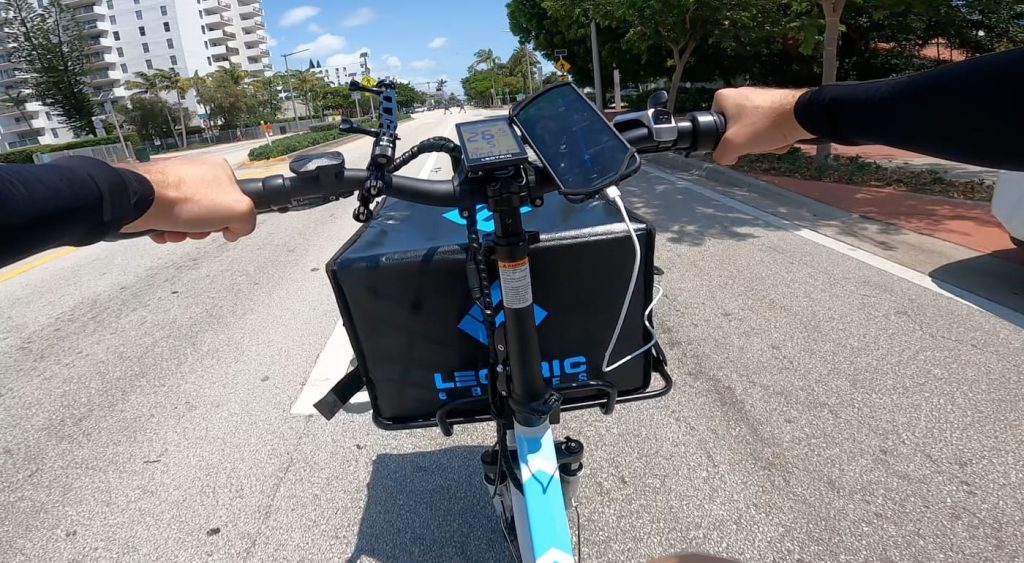
You might have to go shopping
Another surprise was that I sometimes had to do people’s shopping. Doordash gave me a type of limited credit card when I signed up, and twice I had to shop for things people ordered on Doordash.
The first was at a liquor store, where I had to buy some guy’s booze and then scan his ID when I got to his apartment. The second was a CVS order where someone needed a pink hairbow immediately, so they ordered it for delivery.
CVS stores aren’t known for being easy to find things, let alone a single hairbow. And I don’t know if you’ve ever seen a liquor store in Florida, but booze is apparently the state bird, and these things are like a Costco of alcohol. Good luck finding a specific bottle of obscure champagne and getting on your way by the deadline.

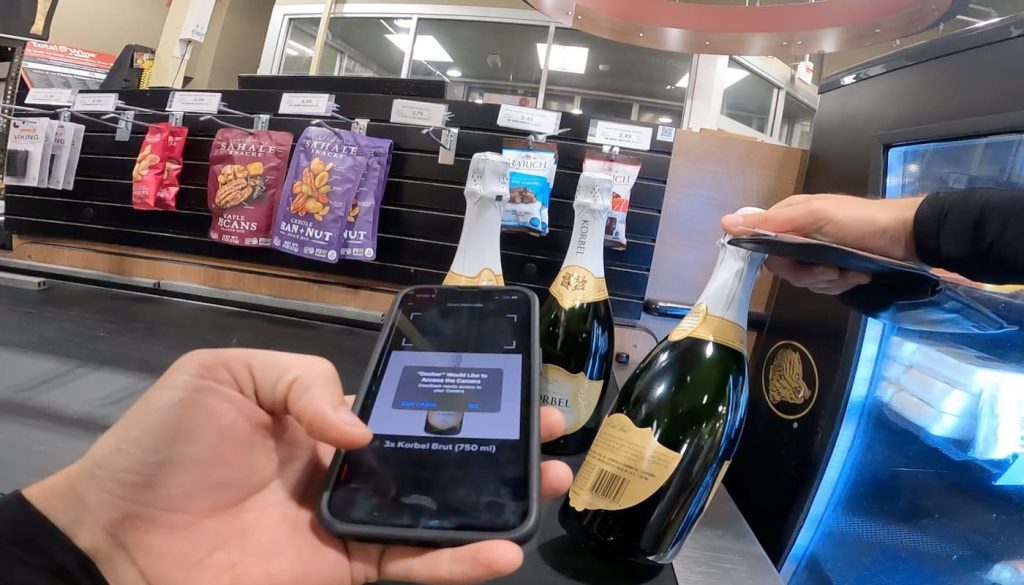
A second battery definitely makes things easier
If you’re going to do delivery work on an e-bike, having a second battery is a good thing to consider. I tried to go easy on my first battery and make it last, but there were times that I throttled at full-speed comfortably knowing I had a spare battery in case I drained my first one.
The downside is there usually isn’t a good place to lock a second battery on a bike – unless you have – and so I kept my spare battery in one of my two food bags. I was constantly worried someone would steal it while I was handing off a delivery, so I always rushed back so as not to leave my bike unattended very long.
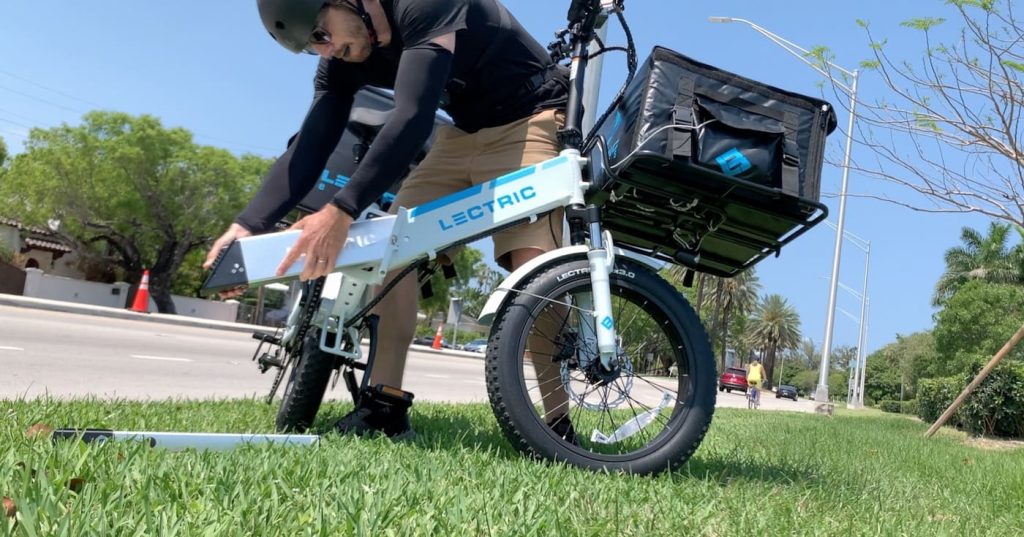
You should always tip your delivery rider
If you’re one of those people who says “I shouldn’t tip because their company should pay workers fairly instead of me paying their wages” then you’re 50% correct and 100% a jerk.
Yes, companies should pay workers fairly. But they don’t, at least not in the US. Until then, service workers who are not getting an hourly wage (like food delivery riders) depend on those tips as real income. They’ve got families to feed and bills to pay, just like you.
Over half of my earnings for the day came from tips. Without those tips, I would have earned around $5/hr just from the base pay.
So please tip your delivery rider. I always did before, but now I tip even better. And when it’s raining outside or rockets are falling, I tip delivery riders even better than that.
These people do hard work that is not made any easier by society, road infrastructure, or pretentious jerks wondering why their burger is 2 minutes late from a delivery rider sporting a fresh dog bite.
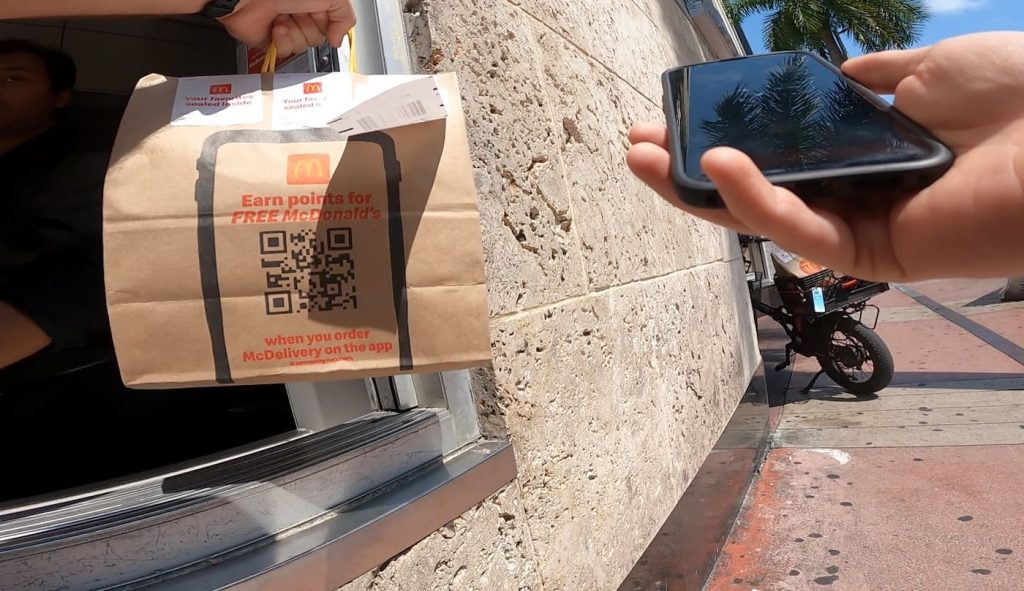
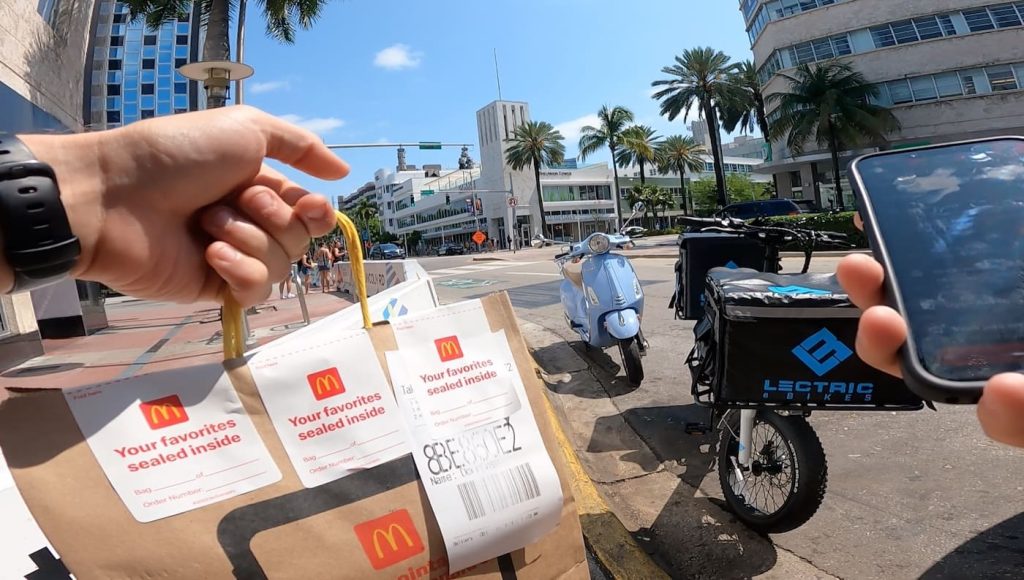
In conclusion
I still firmly believe two-wheelers are the only correct way to deliver food in cities. I’ve never seen a car deliver food where I live, and it’s the same for every European city I’ve ever ordered food in, with the exception of car-loving Germany.
Why we need slow-moving 4,500 lb (2,000 kg) vehicles to deliver a sandwich in a city is beyond me. In a city environment, food arrives faster on a bike, it requires less energy, and it’s better for the air we breathe. Everyone wins.
But there are some serious problems here too. These riders are doing critical work for very little pay and even less respect. They sometimes risk their lives, yet if they ever get hit by a car, there’s no one offering health insurance to heal them. And on top of all that, the delivery apps seem to prioritize car drivers instead of bike riders, further limiting their ability to earn a living wage.
I’m not saying I have all the answers here. But I do know that work needs to be done to improve this system. And I also know one other thing: now I’m hungry.
Author: Micah Toll
Source: Electrek



